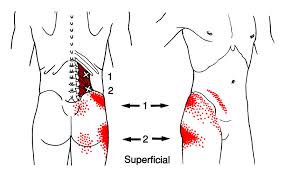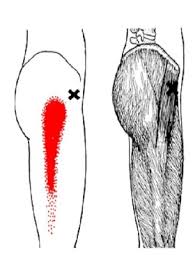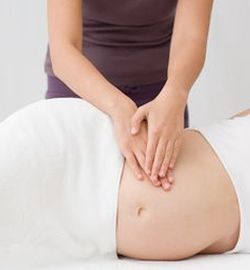There are many sources of hip pain, ranging from muscular trigger points to Osteoarthritis. In order to properly assess hip pain, many things must be considered, including your age, physical activiti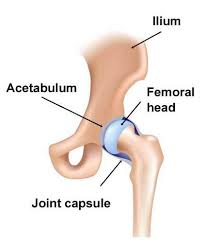 es and overall health. Hip pain may be felt right at the hip joint, in the posterior portion of the hip in the buttocks, or in the front of the hip.
es and overall health. Hip pain may be felt right at the hip joint, in the posterior portion of the hip in the buttocks, or in the front of the hip.
The hip joint is a ball and socket joint created by the articulation of the pelvis and the femur. It is the 2nd largest weight bearing joint (the knee being 1st). It has a lot of stability due to the snug fit of the joint as well as the strong ligaments and muscles that attach to it.
As you can see below, there are many muscles that can have influence on the function of the hip. Imbalances in these muscles can lead to early wear and tear of the joint.
Muscular trigger points that cause hip pain
The gluteus maximus muscle can harbor 3 trigger points that create pain in various places on the posterior hip as well as right on the hip joint. Discomfort can be felt when sitting, bending forward or walking up a hill. There can be tenderness on the sacrum and pain may radiate into the upper part of the posterior thigh. The 2nd trigger point can create pain that feels deep.
Gluteus medius trigger points (right) can cause pain when walking or sleeping on the affected side. They may be accompanied by lower back pain or pain around the sacrum and on the SI joint.
Gluteus minimus trigger points (below) can create sciatica-like symptoms that include pain in the buttocks, posterior and later thigh and calf muscles. There may be pain rising from a seated position and when these trigger points are very active, it is difficult to find a position that is comfortable.
The piriformis muscle is the only muscle that has an attachment on the inside of th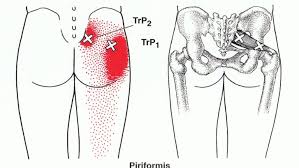 e pelvis. It also has a unique anatomical location in that the sciatic nerve runs beneath the muscle’s fibers. In about 15% of the population, the sciatic nerve actually runs between the fibers. Tension and trigger points in this muscle can create a variety of issues including:
e pelvis. It also has a unique anatomical location in that the sciatic nerve runs beneath the muscle’s fibers. In about 15% of the population, the sciatic nerve actually runs between the fibers. Tension and trigger points in this muscle can create a variety of issues including:
- Low back pain at the base of the spine
- Hip pain around the hip joint
- Gluteal pain that increases during sitting, standing, squatting, or when crossing the legs,
- Leg pain down into the back of the thigh
- Walking with a limp
- Sciatic nerve pain (when the muscle is compressing the nerve)
- Visceral complaints such as deep pelvic pain, constipation, erectile dysfunction, vaginal dryness (when the inner 3rd of the muscle that attaches on the inside of the sacrum irritates the sacral plexus of nerves)
What is often overlooked by medical practitioners is the muscle’s ability to simply “irritate” the sciatic nerve. When this happens, there may be no pain in the hip, but rather an issue that is formed somewhere along the nerve path (usually at the end of the nerve). Plantar fasciitis and calf cramps are two examples of conditions that can be caused by a tight piriformis muscle when it irritates the sciatic nerve. In both cases, if the cramps or foot pain are only treated as local conditions, the therapy will not succeed. The pressure from the nerve must be released by treating the piriformis muscle.
The quadratus lumborum muscle is a muscle of the low back. The active trigger points in the QL can cause pain in the low back, hip joint, SI joint, buttocks and groin.
The tensor fascia late muscle (left) attaches to the front of the pelvis, crosses over the hip joint where it attaches to the femus, and continues into the iliotibial band on the lateral side of the thigh. An active trigger point in the TLF muscle can cause pain at the hip joint that radiates down to the knee. This can be misdiagnosed as hip bursitis. It causes pain when laying on the affected side and when going from sitting to standing after being in a flexed position for an extended time (driving, sleeping in a fetal positon).
Hip Osteoarthritis
Osteoarthritis is a degenerative disease due to wear and tear of a joint. The first clinical signs usually occur after the age of 50. In the beginning stages, OA causes joint weakness, morning stiffness and moderate pain after activity. As the degeneration of the joint progresses, the intensity of the pain increases and the joint becomes more unstable, and muscle atrophy is present. There are typically flare-ups where the pain is worse and there is additional inflammation in the soft tissue around the joint. Clicking sounds may be heard with movements of the hip. The degeneration continues until a joint replacement is necessary.
after the age of 50. In the beginning stages, OA causes joint weakness, morning stiffness and moderate pain after activity. As the degeneration of the joint progresses, the intensity of the pain increases and the joint becomes more unstable, and muscle atrophy is present. There are typically flare-ups where the pain is worse and there is additional inflammation in the soft tissue around the joint. Clicking sounds may be heard with movements of the hip. The degeneration continues until a joint replacement is necessary.
Without an x-ray, it is difficult to diagnose hip pain as Osteoarthritis, as the pain tends to appear in different locations. It may be felt in the groin, thigh, or buttocks and even down to the knee. The pain can be very sharp, or present as a dull ache with stiffness. Over time, range of motion in the hip will decrease and the patient may walk with a limp.
Massage therapy is not only helpful, but necessary for people who have Osteoarthritis of the hip. As the degeneration progresses, the soft tissue around the joint because very tight due to protective muscle guarding. Left untreated, the shortening of the hip muscles contributes to faster degeneration of the joint due to imbalances that are created. Muscular trigger points that develop can create additional hip pain that is not associated with the joint itself. If regular massage is started in the early stages of OA, it can help slow down the progression of the disease by decreasing pressure on the joint.








